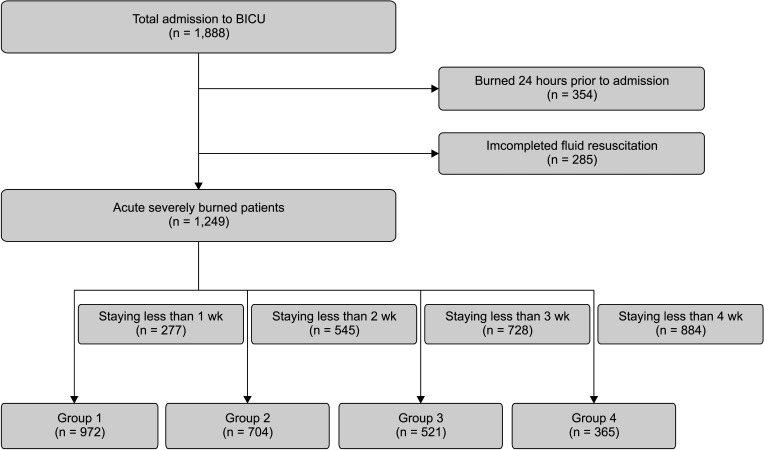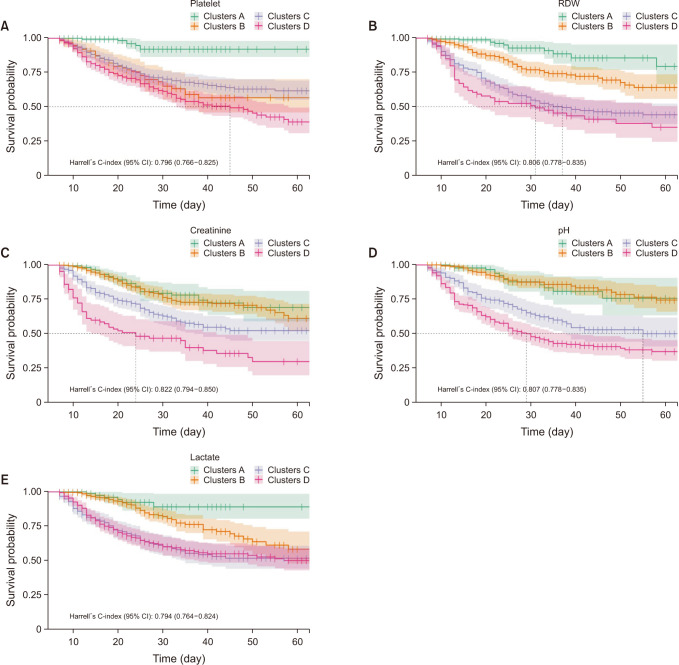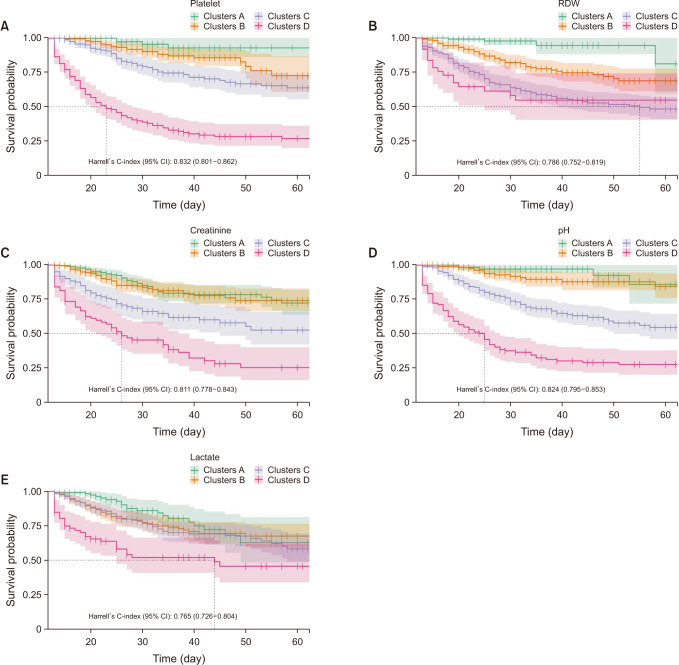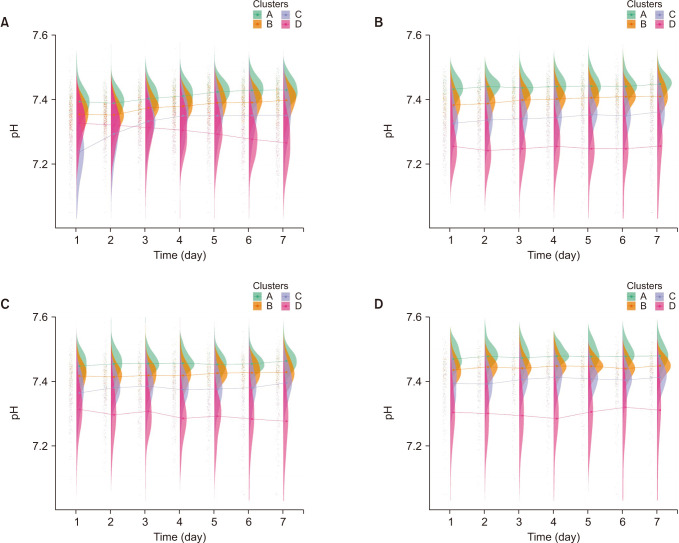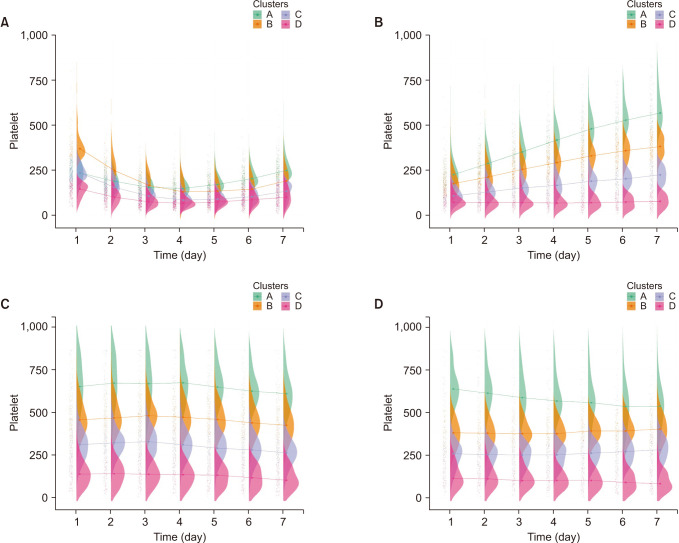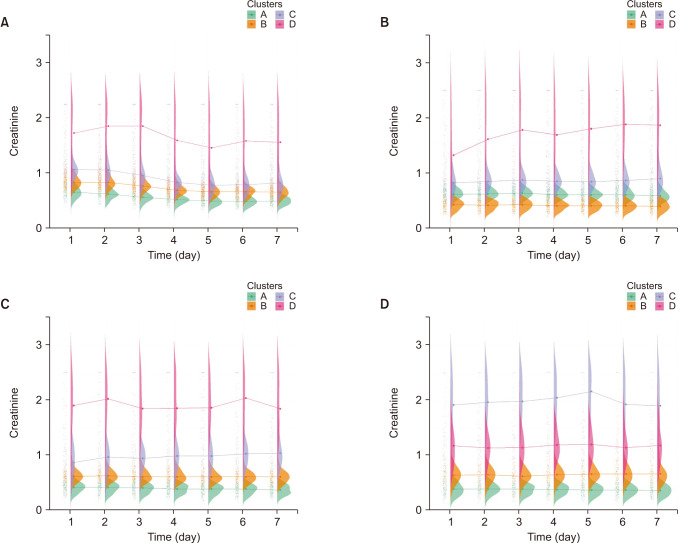Ann Surg Treat Res.
2023 Feb;104(2):126-135. 10.4174/astr.2023.104.2.126.
Longitudinal profile of routine biomarkers for mortality prediction using unsupervised clustering algorithm in severely burned patients: a retrospective cohort study with prospectively collected data
- Affiliations
-
- 1Department of Surgery and Critical Care, Burn Center, Hangang Sacred Heart Hospital, Hallym University Medical Center, Seoul, Korea
- 2Burn Institutes, Hangang Sacred Heart Hospital, Hallym University Medical Center, Seoul, Korea
- KMID: 2539227
- DOI: http://doi.org/10.4174/astr.2023.104.2.126
Abstract
- Purpose
Burn injury has high clinical heterogeneity and worse prognosis in severely burned patients. Clustering algorithms using unsupervised methods to identify groups with similar trajectories in heterogeneous disease patients can provide insight into mechanisms of disease pathogenesis. This study analyzed routinely collected biomarkers to evaluate mortality prediction, find clinical meanings for these or their subtypes, and evaluate patterns.
Methods
This retrospective cohort study included patients aged >18 years, between July 2012 and June 2021. All eligible patients received fluid resuscitation and survived for at least 7 days. Characteristics of clinical interest to the physician at 4 clinically important time points were evaluated.
Results
Eligible patients were divided into 4 subgroups according to these time points: from 1st week to 4th week. Total of 1,249 patients admitted within 2 days after burns and receiving fluid resuscitation were included. Mean Harrell’s C-index of pH was the highest (0.816), followed by platelets (0.807), creatinine (0.796), red cell distribution width (RDW, 0.778), and lactate (0.759). Longitudinal profiles among biomarkers were different.
Conclusion
The main predictors were pH, platelets, creatinine, RDW, and lactate. Creatinine and RDW showed consistent patterns. The other markers varied according to patient condition. Thus, these markers could provide clues into underlying mechanisms and predict mortality.
Keyword
Figure
Reference
-
1. Torres MJ, Peterson JM, Wolf SE. Detection of infection and sepsis in burns. Surg Infect (Larchmt). 2021; 22:20–27. PMID: 33021433.2. Huang X, Liu L, Ning J, Li L, Shen Y. Estimation of the distribution of longitudinal biomarker trajectories prior to disease progression. Stat Med. 2019; 38:2030–2046. PMID: 30614014.3. Genolini C, Lacombe A, Écochard R, Subtil F. CopyMean: a new method to predict monotone missing values in longitudinal studies. Comput Methods Programs Biomed. 2016; 132:29–44. PMID: 27282225.4. Kim Y, Kym D, Hur J, Jeon J, Yoon J, Yim H, et al. Development of a risk prediction model (Hangang) and comparison with clinical severity scores in burn patients. PLoS One. 2019; 14:e0211075. PMID: 30726241.5. Genolini C, Ecochard R, Benghezal M, Driss T, Andrieu S, Subtil F. kmlShape: an efficient method to cluster longitudinal data (time-series) according to their shapes. PLoS One. 2016; 11:e0150738. PMID: 27258355.6. Park SY, Park JE, Kim H, Park SH. Review of statistical methods for evaluating the performance of survival or other time-to-event prediction models (from conventional to deep learning approaches). Korean J Radiol. 2021; 22:1697–1707. PMID: 34269532.7. Marck RE, van der Bijl I, Korsten H, Lorinser J, de Korte D, Middelkoop E. Activation, function and content of platelets in burn patients. Platelets. 2019; 30:396–402. PMID: 29553873.8. Yoon J, Kym D, Won JH, Hur J, Yim H, Cho YS, et al. Trajectories of longitudinal biomarkers for mortality in severely burned patients. Sci Rep. 2020; 10:16193. PMID: 33004974.9. Cato LD, Wearn CM, Bishop JR, Stone MJ, Harrison P, Moiemen N. Platelet count: a predictor of sepsis and mortality in severe burns. Burns. 2018; 44:288–297. PMID: 29032970.10. Guo J, Qin Q, Hu H, Zhou D, Sun Y, Deng A. Red cell distribution width (RDW) as a prognostic tool in burn patients. Clin Lab. 2016; 62:1973–1978. PMID: 28164525.11. Steuerman Y, Wasserman A, Zeltser D, Shapira I, Trotzky D, Halpern P, et al. Anemia measurements to distinguish between viral and bacterial infections in the emergency department. Eur J Clin Microbiol Infect Dis. 2019; 38:2331–2339. PMID: 31493048.12. Rehou S, Jeschke MG. Admission creatinine is associated with poor outcomes in burn patients. Burns. 2022; 48:1355–1363. PMID: 34893369.13. Kimmel LA, Wilson S, Walker RG, Singer Y, Cleland H. Acute kidney injury: it’s not just the ‘big’ burns. Injury. 2018; 49:213–218. PMID: 29173963.14. Clark A, Neyra JA, Madni T, Imran J, Phelan H, Arnoldo B, et al. Acute kidney injury after burn. Burns. 2017; 43:898–908. PMID: 28412129.15. Prowle JR, Kirwan CJ, Bellomo R. Fluid management for the prevention and attenuation of acute kidney injury. Nat Rev Nephrol. 2014; 10:37–47. PMID: 24217464.16. Mosier MJ, Pham TN, Klein MB, Gibran NS, Arnoldo BD, Gamelli RL, et al. Early acute kidney injury predicts progressive renal dysfunction and higher mortality in severely burned adults. J Burn Care Res. 2010; 31:83–92. PMID: 20061841.17. Mokline A, Abdenneji A, Rahmani I, Gharsallah L, Tlaili S, Harzallah I, et al. Lactate: prognostic biomarker in severely burned patients. Ann Burns Fire Disasters. 2017; 30:35–38. PMID: 28592932.18. Steinvall I, Elmasry M, Abdelrahman I, El-Serafi A, Sjöberg F. Addition of admission lactate levels to Baux score improves mortality prediction in severe burns. Sci Rep. 2021; 11:18038. PMID: 34508143.
- Full Text Links
- Actions
-
Cited
- CITED
-
- Close
- Share
- Similar articles
-
- A Clustering Tool Using Particle Swarm Optimization for DNA Chip Data
- Development of a Biomarker-Based Diagnostic Algorithm for Posttraumatic Syndrome after Physical Injury: Design of the BioPTS Study
- Multiscale self-quotient filtering for an improved unsupervised retinal blood vessels characterisation
- To Determine the Risk-Based Screening Interval for Diabetic Retinopathy: Development and Validation of Risk Algorithm from a Retrospective Cohort Study
- Biomarkers and genetic factors for early prediction of pre-eclampsia

